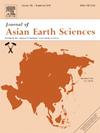巴基斯坦下印度河盆地早白垩世塔尔哈尔页岩有机质成藏的古环境条件及关键驱动因素
IF 2.7
3区 地球科学
Q2 GEOSCIENCES, MULTIDISCIPLINARY
引用次数: 0
摘要
Talhar页岩(早白垩世)是下Goru组的重要组成部分,厚度显著(平均70 m),广泛分布于下印度河盆地(LIB)。尽管具有重要的地质意义,但影响有机质成藏的关键因素尚不清楚。本研究旨在通过有机地球化学和无机地球化学数据分析,评价烃源岩潜力,重建早白垩世古环境,识别控制塔里木页岩有机质成藏的主要因素,弥补这一空白。研究结果表明,塔里木盆地塔哈尔页岩有机碳含量较高,平均为2.27 wt%,主要由ⅱ型干酪根组成。页岩已进入主要生烃阶段,是热成熟、有远景的烃源岩。SiO2含量高,属于硅质页岩,且大部分微量元素较上陆壳富集,表明其在该地区的元素重要性。分析的早白垩世数据的氧化还原敏感参数表明,与赤道地区的缺氧或缺氧条件相比,全球氧条件向两极发展。早白垩世塔尔哈尔页岩沉积时期以氧-缺氧条件为主,淡水咸化条件下沉积速率较高,古生物生产力较高。古生产力、古气候、古盐度、可能的高沉积速率和热液活动是影响有机质聚集的关键因素,而氧化还原条件似乎起着次要作用。这些结果证明了对塔尔哈尔页岩进行更全面的勘探是合理的,突出了它作为烃源岩的潜力,以及它对了解早白垩世全球古环境动力学的更广泛意义。这项研究有助于古环境重建的全球论述,并将塔尔哈尔页岩定位为LIB内外的重要地质特征。本文章由计算机程序翻译,如有差异,请以英文原文为准。

Paleoenvironmental conditions and key drivers of organic matter accumulation in the early cretaceous Talhar Shale, Lower Indus Basin, Pakistan
The Talhar Shale (early Cretaceous), a key member of the Lower Goru Formation, is notably thick (averaging 70 m) and extensively found throughout the Lower Indus Basin (LIB). Despite its geologic significance, the key factors influencing organic matter (OM) accumulation are still unknown. This study aims to address this gap by analyzing both organic and inorganic geochemical data to evaluate the source rock potential, reconstructing the early Cretaceous paleoenvironment, and identifying the primary factors controlling OM accumulation in the Talhar Shale. Our findings reveal that the Talhar Shale exhibits a high total organic carbon content (averaging 2.27 wt%) and is mainly composed of type II kerogen. The shale has reached the main stage of hydrocarbon generation, affirming its status as a thermally mature and prospective source rock for oil and gas. Additionally, the high concentration of SiO2 classifies it as a siliceous shale, and most trace elements show their enrichment compared to the upper continental crust, signifying its elemental importance in the region. Redox-sensitive parameters of the analyzed early Cretaceous data indicate global oxic conditions towards the poles, compared to oxygen-deficient or anoxic conditions towards the equatorial regions. However, the oxic to suboxic conditions predominantly prevailed during the deposition of early Cretaceous Talhar Shale, with moderately higher paleo-bioproductivity driven by a relatively high sedimentation rate under freshwater saline conditions. Moreover, our analysis proposes paleoproductivity, paleoclimate, paleosalinity, possible high sedimentation rate, and hydrothermal activities as the key factors influencing OM accumulation, while redox conditions appear to have played a lesser role. These results justify a more comprehensive exploration of the Talhar Shale, highlighting its potential as a source rock and its broader implications for understanding global paleoenvironmental dynamics during the early Cretaceous. This study contributes to the global discourse on paleoenvironmental reconstruction and positions the Talhar Shale as a significant geological feature within the LIB and beyond.
求助全文
通过发布文献求助,成功后即可免费获取论文全文。
去求助
来源期刊

Journal of Asian Earth Sciences
地学-地球科学综合
CiteScore
5.90
自引率
10.00%
发文量
324
审稿时长
71 days
期刊介绍:
Journal of Asian Earth Sciences has an open access mirror journal Journal of Asian Earth Sciences: X, sharing the same aims and scope, editorial team, submission system and rigorous peer review.
The Journal of Asian Earth Sciences is an international interdisciplinary journal devoted to all aspects of research related to the solid Earth Sciences of Asia. The Journal publishes high quality, peer-reviewed scientific papers on the regional geology, tectonics, geochemistry and geophysics of Asia. It will be devoted primarily to research papers but short communications relating to new developments of broad interest, reviews and book reviews will also be included. Papers must have international appeal and should present work of more than local significance.
The scope includes deep processes of the Asian continent and its adjacent oceans; seismology and earthquakes; orogeny, magmatism, metamorphism and volcanism; growth, deformation and destruction of the Asian crust; crust-mantle interaction; evolution of life (early life, biostratigraphy, biogeography and mass-extinction); fluids, fluxes and reservoirs of mineral and energy resources; surface processes (weathering, erosion, transport and deposition of sediments) and resulting geomorphology; and the response of the Earth to global climate change as viewed within the Asian continent and surrounding oceans.
 求助内容:
求助内容: 应助结果提醒方式:
应助结果提醒方式:


